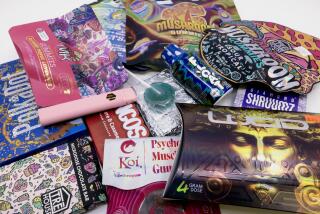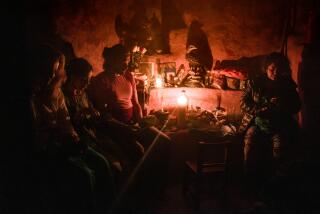Dull Brown Tasmanian Poppies Bring in Green : Opium: The dried flower heads are sold to two pharmaceutical companies, netting about 600 growers $6.8 million to $8.1 million a year.
- Share via
HOBART, Australia — Every year, one of the world’s most tempting crops tints fields a seductive white and mauve on the Australian island of Tasmania.
The opium-poppy fields eventually turn a banal brown in the hot sun, which gives them the consistency of straw. It’s then, usually in March--a summer month down here--that they have the most allure for farmers.
The dried poppies are sold to two pharmaceutical companies, bringing about 600 growers $6.8 million to $8.1 million a year.
It’s a relatively new income source for Tasmania. The first commercial crop was produced in 1970, and large-scale production began a few years later.
Poppies were introduced to the island by one of the two drug companies, Glaxo of Great Britain, which had been seeking a secure new source of the valuable flowers.
“Tasmania,” according to a government statement, “offered a good combination of climate, soil and experienced farmers, a small, law-abiding community with virtually no drug problems and, above all, a remote location.”
Glaxo and the other company, Tasmanian Alkaloids, a subsidiary of the U.S. corporation Johnson & Johnson, convert the harvest into a substance known as poppy-straw concentrate, from which morphine is extracted, principally to produce codeine.
Australia produces 35% to 40% of the world’s morphine. Tasmania holds the record yield per acre for morphine and supplies roughly 25% of the world’s codeine.
In pill form, codeine relieves pain after operations or tooth extractions; in syrups, it soothes coughs. Both codeine and morphine are key ingredients in millions of prescriptions.
For additional income, growers separate poppy seed from the flowers for food seasoning. Blue poppy seeds such as those produced in Tasmania command the highest price on the international spice market.
“When you look at the multiplier effect on the local community by way of processing, crop transport, labor, fertilizers and the like, we estimate the value of the poppy to Tasmania is in the vicinity of $40.8 million to $47.6 million annually,” said Julian Green, chairman of the Poppy Advisory and Control Board of Tasmania.
Protecting these economic stakes has a high priority, and officials here say that diversion of poppies for illicit uses is minuscule--the equivalent of 2.2 pounds of morphine--compared with the diversion from other poppy-growing areas of the world.
Raising the crop on an island with a population of slightly more than 450,000 helps. Drug users rarely escape notice in the island’s tightly knit communities, and smuggling is difficult.
But the best security is the alliance between the police and the growers. Poppy farmers, who must renew their licenses annually, are expected to notify police immediately of any strange vehicles or people. Following farmers’ leads, police often stake out fields at night.
Neil Brown, a security specialist with the control board and a former detective, said the tight surveillance works because “nobody’s going to warn off culprits.”
Brown once asked for police help in apprehending poppy thieves on an obscure hilltop. “They caught two women who’d been making a little feast of the place,” he said. “We called it ‘the supermarket.’ ”
As a result of the minimal security problems, Tasmanian farmers and the drug companies have been able to concentrate on increasing production, which has become more mechanized. Precision machinery seeds and fertilizes fields, sprays herbicides and harvests the dried flowers.
The emphasis on efficiency is paying off. “We’re getting about 3.3 pounds of morphine per ton of crop,” estimates Wayne Smith, president of the island’s poppy growers’ association. “And every year we’re looking at new cultivars to increase that yield.”
With wool prices falling--wool exports are one of the largest sources of income on the island--the poppy trade has become increasingly important.
“It’s been a great help to our cash flow and net farm income,” grower Michael Crisp said. Crisp usually plants about 37 acres in poppies. The average spread is closer to 25 acres.
The average gross return from the crop is about $680 to $800 per acre, according to the Poppy Advisory and Control Board.
Farmers plant their poppies in different fields each year to help their other crops. Poppy roots tunnel as much as six feet into the soil. “We find that they bust up the old subsoil, so it’s all ready for ordinary food crops such as onions or potatoes,” Smith said.
One thing that bothers the island’s poppy farmers is the rather static market for their crop, most of which goes to England and Europe. Under U.S. law, India, and to a lesser extent Turkey, command 80% of the lucrative U.S. market for legal unprocessed narcotics. The law is based on the belief that their domination of the market helps control opium smuggling.
But this strategy may not be working. A U.S. State Department report estimates that as much as 10% to 30% of India’s opium crop is being diverted to the illicit drug market. The United States has given India two years either to stem the seepage or face reduced U.S. opium imports.
Bolstered by its exemplary security record, Tasmania would be eager to pick up the slack.
More to Read
Sign up for Essential California
The most important California stories and recommendations in your inbox every morning.
You may occasionally receive promotional content from the Los Angeles Times.










